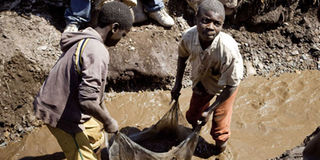DRC children quit school for the mines

Children wash copper on July 9, 2010 at an open-air mine in Kamatanda in the rich mining province of Katanga, southeastern Democratic Republic of Congo (DRC). Some 400 children from Kamatanda and surrounding villages, who have dropped out of school, help miners transport, sort or wash the mineral. Forced by poverty, hundreds of children leave school to work at the mine. AFP PHOTO / GWENN DUBOURTHOUMIEU
KAMATANDA, DRC, Saturday
Barefoot with water up to his knees, seven-year-old Isaac sifts through sand to extract copper like hundreds of boys in southeast DR Congo, forced by poverty to quit school and work in the mines.
Isaac abandoned his maths and language classes in February, leaving the only school in Kamatanda, a small village in Katanga province, the main mining region in the Democratic Republic of Congo.
Since then, he has worked in a vast open copper mine in the area, helping some 2,000 “diggers” extract the mineral under a blistering sun, then to sell to businesses in Likasi, a nearby town.
There are about 400 children from Kamatanda and other surrounding villages who contribute to the effort by sorting, carrying, or cleaning the mineral.
Katanga province contains more than 30 per cent of the world’s reserves of cobalt and 10 per cent of the copper, in addition to tin, gold and uranium, but many illegal workers and children are involved in the extraction process.
Four dollars
Isaac says he earns less than four dollars (Sh320) each day in the mine, “and with that I can buy clothes and contribute to the expenses at home,” he explains, his face still full of childhood innocence.
He is the third child in a family of eight, and when his parents could not afford the $30 (Sh2,400) needed to pay his yearly school fee he joined his brothers and sisters in the mine.
Alphonsine Fumbi is one of the three teachers at the school in Kamatanda, which is made up of three rooms without doors or windows. She finished the school year with just 19 pupils, down from 37 when classes began.
Thirty per cent of students in the school receive support from the Belgian non-governmental organisation Groupe One, which campaigns against child labour in the mines.
In 2009, “we identified 300 children in Kamatanda. We are trying to fund activities that generate revenue for the parents whose school children we will look after,” Evelyne Kanjinga from Groupe One says.
The organisation’s budget can only stretch to assure the studies of 150 children in Kamatanda, providing each with a payment covering the costs of enrollment fees, school uniforms and necessary equipment for class.
According to Kanjinga, some parents depend heavily on the income from “assistant diggers” and encourage their children to leave school and work in the mines.
A study by the United Nations Children’s Fund in 2006 reported some 20,000 children working in mines in mineral-rich Katanga, a province as large as France. (AFP)




